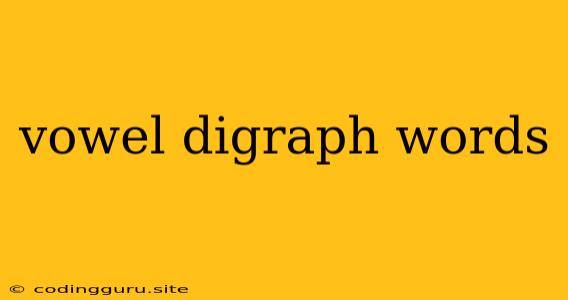Unlocking the Secrets of Vowel Digraphs: A Guide to Understanding These Word Builders
Have you ever wondered how certain combinations of letters can create sounds that seem impossible? That's the magic of vowel digraphs, fascinating duos of vowels that work together to produce unique sounds. They're like secret agents in the world of spelling, adding richness and depth to the English language.
What are Vowel Digraphs?
Imagine a pair of singers, each with a distinct voice, combining their talents to create a harmonious melody. That's exactly what vowel digraphs do in words. They're two vowels working together to form a single sound.
Examples of Common Vowel Digraphs:
- "ai" - As in "rain," "wait," "fail," "paint"
- "ay" - As in "play," "say," "stay," "day"
- "ee" - As in "see," "tree," "feet," "bee"
- "ea" - As in "read," "bread," "seat," "team"
- "ie" - As in "pie," "tie," "lie," "die"
- "oa" - As in "boat," "coat," "road," "soap"
- "oo" - As in "moon," "food," "book," "look"
- "ou" - As in "house," "mouse," "south," "cloud"
Why Are Vowel Digraphs Important?
Vowel digraphs are crucial for understanding and mastering the complexities of the English language. They help us:
- Improve our reading skills: Recognizing these combinations in words makes reading smoother and faster.
- Enhance our spelling abilities: Knowing how vowel digraphs work allows us to spell words correctly.
- Strengthen our vocabulary: By understanding vowel digraphs, we can unlock the meanings of words and expand our vocabulary.
Mastering Vowel Digraphs: Tips and Tricks
Here's how to conquer the world of vowel digraphs:
- Start with the Basics: Learn the common vowel digraphs and their corresponding sounds.
- Focus on the Context: The sound a vowel digraph makes can vary depending on its position in the word. For example, "ea" in "bread" sounds different from "ea" in "team."
- Practice, Practice, Practice: The more you read and write, the more familiar you'll become with vowel digraphs and their sounds.
- Utilize Resources: There are plenty of online resources and games designed specifically to help you learn vowel digraphs.
Examples of Words Containing Vowel Digraphs:
- "Sail" (ai)
- "Play" (ay)
- "Meet" (ee)
- "Read" (ea)
- "Tie" (ie)
- "Boat" (oa)
- "Moon" (oo)
- "House" (ou)
The Importance of Phonics
Understanding vowel digraphs is a crucial part of phonics, a method of teaching reading and spelling based on the sound-letter relationships in the English language. By learning about vowel digraphs and other phonics concepts, you gain a deeper understanding of how our language works.
Conclusion
Vowel digraphs are fascinating elements of the English language that add complexity and richness to our vocabulary. Learning about them enhances our reading, spelling, and overall language skills. With practice and a little determination, you can unlock the secrets of vowel digraphs and become a more confident and skilled communicator.
